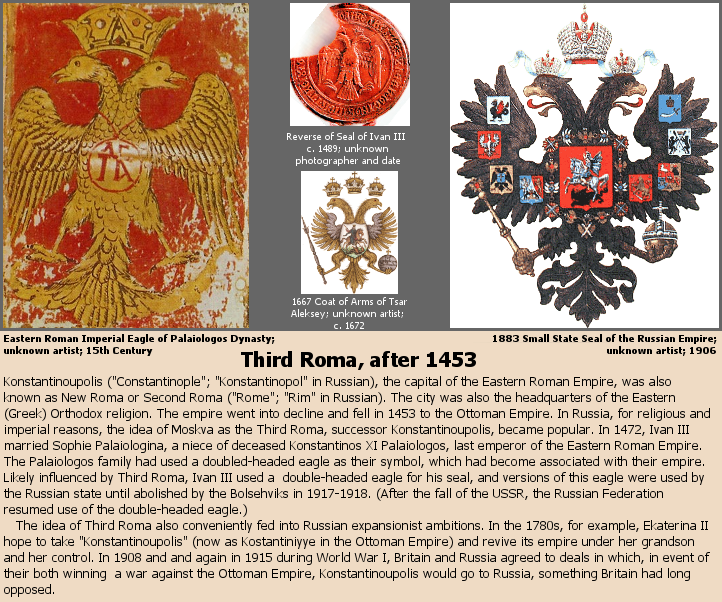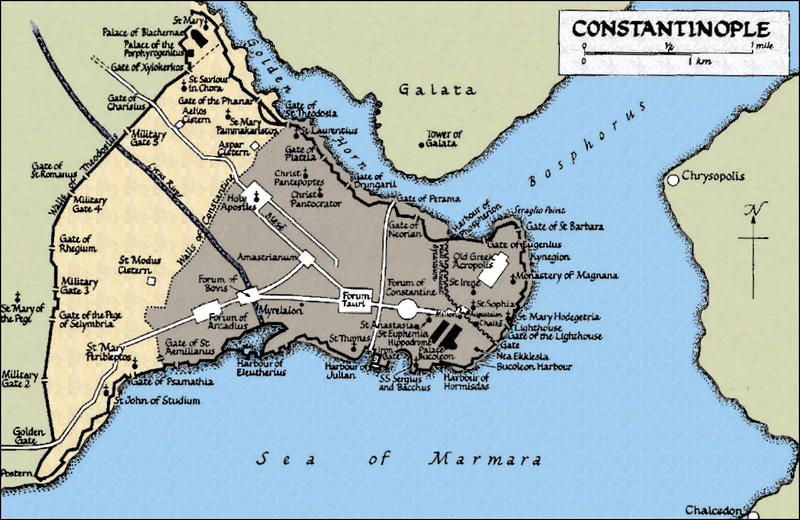

Third Roma, after 1453
Konstantinoupolis ("Constantinople"; "Konstantinopol" in Russian), the capital of the Eastern Roman Empire, was also known as New Roma or Second Roma ("Rome"; "Rim" in Russian). The city was also the headquarters of the Eastern (Greek) Orthodox religion. The empire went into decline and fell in 1453 to the Ottoman Empire. In Russia, for religious and imperial reasons, the idea of Moskva as the Third Roma, successor Konstantinoupolis, became popular. In 1472, Ivan III married Sophie Palaiologina, a niece of deceased Konstantinos XI Palaiologos, last emperor of the Eastern Roman Empire. The Palaiologos family had used a doubled-headed eagle as their symbol, which had become associated with their empire. Likely influenced by Third Roma, Ivan III used a double-headed eagle for his seal, and versions of this eagle were used by the Russian state until abolished by the Bolsehviks in 1917-1918. (After the fall of the USSR, the Russian Federation resumed use of the double-headed eagle.)
The idea of Third Roma also conveniently fed into Russian expansionist ambitions. In the 1780s, for example, Ekaterina II hope to take "Konstantinoupolis" (now as Kostantiniyye in the Ottoman Empire) and revive its empire under her grandson and her control. In 1908 and and again in 1915 during World War I, Britain and Russia agreed to deals in which, in event of their both winning a war against the Ottoman Empire, Konstantinoupolis would go to Russia, something Britain had long opposed.
Comments
What's in a Name: Konstantinoupolis
Konstantinoupolis (English "Constantinople"), now called Istanbul, has had many names during the its 2,500+-year existence. Greek colonists founded the city, calling it Byzantion, on the site of an earlier Thracian settlement possibly called Lygos. Byzantion had a strategic naval position, located where the Bosporus strait met the Black Sea. It had a protected harbor, the Golden Horn, where ships could safely shelter behind a massive chain that prevented the entry of hostile ships. Trade through the straits was very important, as lands around the Black Sea grew wheat that merchants sold to Mediterranean cities. The city's warships controlled the strait, allowing Byzantion to tax merchant ships trying to passing by. On land, the city also had a strong tactical position against invading armies, being on a peninsula shielded by water on three sides and by strong walls on the landward side.
When the Latin-speaking Romans conquered Greece and nearby areas, Byzantion became part of their empire. They called the city Byzantium, because this was easier for them to pronounce. (Something similar will happen many times with other foreigners.) In the eastern Mediterranean, the Greeks quickly became many of the administrators and functionaries running the Roman Empire there, and dual Greek/Latin names of places were common for places and sometimes for people. For example, Diokles (his Greek birth name) became Diocletianus in Latin and became the Roman emperor English speakers know as "Diocletian".
Byzantion/Byzantium was razed to the ground when the city ended up on the wrong side during the year of the Five Emperors. It became the capital of one of the losers in 193 AD and underwent a two-year siege until Emperor Septimius Severus took it and destroyed in 195. Its strategic site, however, eventually induced Severus rebuilt it, but he named the city Augustus Antonina (Avgousta Antonini in Greek), in honor of his son and future emperor Antoninus ("Caracalla"). The new name was not popular, and the city reverted to Byzantion/Byzantium after the Severan dynasty ended.
In the Third Century, the Roman Empire underwent frequent civil wars and became very difficult to run by one emperor from one capital. One attempt to solve this was to have two co-emperors and two capitals, one in the west at Roma (later moved to Ravenna) and one in the east at Byzantion/Byzantium. This system did help, but human nature being what it is, it also meant that some co-emperors would go to war with one another. One winner of such a civil war was Constantinus/Konstantinos ("Constantine"), who became sole emperor. (The empire would revert to co-emperors after his death.) Constantine, although originally the western co-emperor, made Byzantion/Byzantium, not Roma, his capital. Under Constantine, the city was at times called New Rome, Second Rome, and various other names (I'll skip the Latin and Greek). Finally, the city ended up being called Constantinopolis (Latin)/Konstantinoupolis (Greek), in honor of the emperor. Greek speakers also sometimes called it by its old name, Byzantion.
The western half of the Roman Empire collapsed in the 5th Century, but the eastern half of the empire soldiered on for many centuries, with Konstantinoupolis at its capital. With the Latin-speaking west gone, "Constantinopolis" fell out of use. As the capital of a major empire that would last for about another thousand years, Konstantinoupolis was known to many peoples in Europe, North Africa, and the Middle East. They mostly called Konstantinoupolis whatever was easier for them to pronounce. Thus, Constantinople in French and English (although with different pronunciations), Konstantinopol in Russian, Konstantinopel in German, Costantinopoli in Italian, Kostantiniyye in Arabic and Turkish, Kustantiniyyah in Persian, and so on.
But wait, there's more! The city had many informal names. For one, the Rus called it Tsargard. In English, this would mean "Tsar's City" or "Emperor's City", "tsar" in Russian meaning emperor, deriving from "Caesar". Gaius Julius Caesar was the winner of a civil war in the late Roman Republic and assumed the top positions of the government, making himself sole ruler of the republic and its extensive empire before he was assassinated. His adoptive son, born Gaius Octavius ("Octavian" in English) but taking the name Gaius Julius Caesar on his adoption, then won the next civil war and made himself emperor. Most successors either were adopted with the name Caesar as heir to the existing emperor or assumed the name Caesar when they became emperor by force or fortune. Over time, "Caesar" became a title meaning "emperor". (Actually, by the time of the eastern Roman empire, Caesar/Kaisar (Greek) was mostly used to denote the heir to the emperor and sometimes to denote a subordinate, deputy emperor. The actual emperor was the Avgoustos (Latin Augustus), deriving from a title that "Octavian" assumed. To many peoples, "Caesar" still meant emperor.)

Map from https://lucerne.fandom.com/wiki/File:Constantinople2.jpg with no attribution information given; available under Creative Commons license CC BY-SA 3.0.
Greeks in the empire also called Konstantinoupolis the "Ruling City" because it was the capital and the "Queen of Cities" for its importance. Like London in parts of Britain or New York City in parts of the USA, Konstantinoupolis was often just called the "City". In Greek, this was the "Polis". The Ottoman Turks gradually wore away the Eastern Roman Empire and finally conquered Konstantinoupolis, its last remnant, in 1453. The city was now called Kostantiniyye, how the Turks pronounced its name, and it became the capital of their empire. The Turks also had a long-standing informal name for the city, Istanbul. This name was their pronunciation of the Greek "stin Poli", meaning "to the City" or "in the City". Istanbul ("Stamboul" or "Stambul" in other languages) at first referred to the part of Kostantiniyye that was within the city walls but later referred to the entire city. Officially, the city was Kostantiniyye during the time of the Ottoman Empire. But, empires fall, and the Ottomans were replaced by the Turkish Republic, which in 1923 moved the capital to Ankara and officially renamed Kostantiniyye as Istanbul.
What's in a Name: Roman Empire, Eastern Roman Empire, Byzantine Empire
The Roman Empire came to have two co-emperors and two capitals, Roma (later moved to Ravenna) in the west and Constantinopolis/Konstantinoupolis in the east. This is sometimes described as the empire dividing itself into two empires, but that's not quite right. It was still one empire, the Imperium Romanum (Latin)/Basileia Rhomaion (Greek, literally Roman Kingdom) or Basileia ton Rhomaion (Greek, literally Kingdom of the Romans). It was just administratively split between two emperors and two capitals. Both halves had considerable problems during the barbarian invasions of the 4th and 5th Centuries, with the Latin-dominated western half collapsing entirely while the Greek-dominated eastern half surviving and later flourishing for some time. The eastern half still considered itself and called itself the Roman Empire (Basileia Rhomaion). However, peoples and countries in the region once ruled by or dominated by the western half of the Roman Empire viewed the western portion as "the" Roman Empire, which by tradition ceased to exist when a barbarian warlord deposed the western emperor and made himself king of Italy (rex Italiae). To them, the Greek-speaking eastern empire was a foreign land, the Eastern Roman Empire or the Empire of the Greeks (Imperium Graecorum in Latin, which was used as a lingua franca in western Europe for centuries). But in the east, this empire remained the Roman Empire to its end, which is what the peoples of eastern Europe, including the Rus and later Russians, knew it as.
But, what about the Byzantine Empire? "Byzantine Empire" was never used during the existence of the "Eastern" Roman Empire. About a century after the empire's collapse in 1453, western Europeans began using "Byzantine Empire" to refer to this empire. Byzantine refers to Byzantium, the Latin name of Byzantion and the name of the city before it became Konstantinoupolis. I think it is thus unfortunate that "Byzantine Empire" eventually became the preferred term in western Europe and in places dominated by western Europe. In these slides, I prefer "Eastern Roman Empire" as the name is least likely to cause confusion while remaining close to what it was actually called.